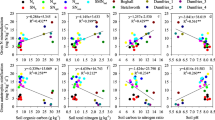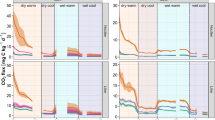Abstract
Here, we examine the effect of long-term pH differences and short-term pH change on N2O emissions from soil, and the microbial source (ammonia oxidation versus denitrification) of 15N-N2O emissions. 15N-fertiliser (20 g N m−2; 10 atom% excess 15N) was applied to (1) a silt loam soil of pH 7 held at 50% and 65% water-filled pore space (WFPS) (experiment 1) and (2) a loamy sand soil maintained at pH 4.5 and pH 7 for over 40 years (experiment 2). Soils were limed with CaCO3 or acidified with H2SO4, and comparisons were made with unadjusted soils. Ammonia oxidation was the main microbial source of 15N-N2O in soils limed to pH 7.0–8.1, unadjusted pH 7.1 (Experiment 1) and long-term pH 7 (experiment 2) soils. Eighty percent of 15N-N2O from the long-term pH 4.5 soil (experiment 2) was derived from denitrification suggesting a possible inhibition of N2O reduction. Short-term acidification to pH 5.6 or 4.3 lowered N2O emissions. Liming of the pH 4.5 soil resulted in over four times greater N2O emission (11 mg 14+15N-N2O m−2 over 41 days) than from the long-term pH 7.0 soil (experiment 2), with an associated increase in ammonia oxidiser-N2O and decrease in denitrifier-N2O production. This is the first report of a pH-induced change in microbial source of N2O. Our results highlight the importance of distinguishing between short- and long-term effects of pH management when predicting N2O emissions from soil, as they exhibit predominance of different microbial groups in N2O production, with likely adaptation of the microbial community.









Similar content being viewed by others
References
Acton SD, Baggs EM (2010) Interactions between N application rate, CH4 oxidation and N2O production in soil. Biogeochem. doi:10.1007/s10533-010-9442-5
Allison SM, Prosser JI (1991) Urease activity in neutrophilic autotrophic ammonia-oxidising bacteria isolated from acid soils. Soil Biol Biochem 23:45–51
Allison SM, Prosser JI (1993) Ammonia oxidation at low pH by attached populations of nitrifying bacteria. Soil Biol Biochem 25:935–941
Avrahami S, Bohannan BJM (2009) N2O emission rates in a California meadow soil are influenced by fertilizer level, soil moisture and the community structure of ammonia-oxidizing bacteria. Glob Chang Biol 15:643–655
Bååth E, Anderson TH (2003) Comparison of soil fungal/bacterial ratios in a pH gradient using physiological and PLFA-based techniques. Soil Biol Biochem 35:955–963
Bäckman JSK, Hermansson A, Tebbe CC, Lindgren PE (2003) Liming induces growth of a diverse flora of ammonia-oxidising bacteria in acid spruce forest soil as determined by SSCP and DGGE. Soil Biol Biochem 35:1337–1347
Baggs EM (2008) A review of stable isotope techniques for N2O source partitioning in soils: recent progress, remaining challenges and future considerations. Rapid Commun Mass Spectrom 22:1664–1672
Bateman EJ, Baggs EM (2005) The contributions of nitrification and denitrification to N2O emissions from soils at different water-filled pore space. Biol Fertil Soil 41:379–388
Blagodatskiy SA, Avksent'ev AA, Davydova MA, Blagodatskaya EV, Kurakov AV (2008) Nitrous oxide production in soils and the ratio of the fungal to bacterial biomass. Eurasian Soil Sci 41:1448–1455
Bremner JM (1997) Sources of nitrous oxide in soils. Nutr Cycl Agroecosyst 49:7–16
Burton SAQ, Prosser JI (2001) Autotrophic ammonia oxidation at low pH through urea hydrolysis. Appl Environ Microbiol 67:2952–2957
Chalk PM, Smith CJ (1983) Chemodenitrification. In: Freney JR, Simpson JR (eds) Gaseous loss of nitrogen from plant soil systems, Martinus Nijhoff and W. Junk, The Hague
Ciarlo E, Conti M, Bartoloni N, Rubio G (2008) Soil N2O emissions and N2O/(N2O + N2) ratio as affected by different fertilization practices and soil moisture. Biol Fertil Soil 44:991–995
Dannenmann M, Butterbach-Bahl K, Gasche R, Willibald G, Papen H (2008) Dinitrogen emissions and the N2:N2O emission ratio of a Rendzic Leptosol as influenced by pH and forest thinning. Soil Biol Biochem 40:2317–2323
De Boer W, Duyts H, Laanbroek HJ (1988) Autotrophic nitrification in a fertilised acid heath soil. Soil Biol Biochem 20:845–850
De Boer W, Gunnewiek PJAK, Veenhuis M, Bock E, Laanbroek HJ (1991) Nitrification at low pH by aggregated chemolithotrophic bacteria. Appl Environ Microbiol 57:3600–3604
De Boer W, Klein Gunnewiek PA, Laanbroek HJ (1995) Ammonium-oxidation at low pH by a chemolithotrophic bacterium belonging to the genus Nitrosospira. Soil Biol Biochem 27:127–132
De Boer W, Laanbroek HJ (1989) Ureolytic nitrification at low pH by Nitrosospira species. Arch Microbiol 152:178–181
Ellis S, Howe MT, Goulding KWT, Mugglestone MA, Dendooven L (1998) Carbon and nitrogen dynamics in a grassland soil with varying pH: effect of pH on the denitrification potential and dynamics of the reduction enzymes. Soil Biol Biochem 30:359–367
Enwall K, Philippot L, Hallin S (2005) Activity and composition of the denitrifying bacterial community respond differently to long-term fertilization. Appl Environ Microbiol 71:8335–8343
Garrido F, Henault C, Gaillard H, Germon JC (2000) Inhibitory capacities of acetylene on nitrification in two agricultural soils. Soil Biol Biochem 32:1799–1802
Goodroad LL, Keeney DR (1984) Nitrous oxide production in aerobic soils under varying pH, temperature and water content. Soil Biol Biochem 16:39–43
Groffman PM, Altabet MA, Bohlke JK, Butterbach-Bahl K, David MB, Firestone MK, Giblin AE, Kana TM, Nielsen LP, Voytek MA (2006) Methods for measuring denitrification: diverse approaches to a difficult problem. Ecol Appl 16:2091–2122
Hankinson TR, Schmidt EL (1984) Examination of an acid forest soil for ammonia- and nitrite-oxidising bacteria. Can J Microbiol 30:1125–1132
Hayatsu M (1993) The lowest limit of pH for nitrification in tea soil and isolation of an acidophilic ammonia-oxidising bacterium. Soil Sci Plant Nutr 39:219–226
IPCC (2007) Climate Change 2007: synthesis report. Contribution of Working Groups I, II and III to the Fourth Assessment Report of the Intergovernmental Panel on Climate Change. Core Writing Team, Pachauri RK, Reisinger A (eds), IPCC, Geneva, Switzerland
Jiang QQ, Bakken LR (1999) Nitrous oxide production and methane oxidation by different ammonia-oxidising bacteria. Appl Environ Microbiol 65:2679–2684
Kemmitt SJ, Wright D, Goulding KWT, Jones DL (2006) pH regulation of carbon and nitrogen dynamics in two agricultural soils. Soil Biol Biochem 38:898–911
Knowles R (1982) Denitrification. Microbiol Rev 46:43–70
Koskinen WC, Keeney DR (1982) Effect of pH on the rate of gaseous products of denitrification in a silt loam soil. Soil Sci Soc Am J 46:1165–1167
Laughlin RJ, Stevens RJ (2002) Soil Sci Soc Am J 66:1540–1548
Maag M, Vinther FP (1996) Nitrous oxide emission by nitrification and denitrification in different soil types and at different soil moisture contents and temperatures. Appl Soil Ecol 4:5–14
Martikainen PJ, De Boer W (1993) Nitrous oxide production and nitrification in acidic soil from a Dutch coniferous forest. Soil Biol Biochem 25:343–347
Mørkved PT, Dorsch P, Bakken LR (2007) The N2O product ratio of nitrification and its dependence on long-term changes in soil pH. Soil Biol Biochem 39:2048–2057
Morley N, Baggs EM, Dörsch P, Bakken L (2008) Production of NO, N2O and N2 by extracted soil bacteria; regulation by NO −2 and O2 concentrations. FEMS Microbiol Ecol 65:102–112
Nägele W, Conrad R (1990) Influence of pH on the release of NO and N2O from fertilised and unfertilised soil. Biol Fertil Soil 10:139–144
Nicol GW, Leininger S, Schleper C, Prosser JI (2008) The influence of soil pH on the diversity, abundance and transcriptional activity of ammonia oxidizing archaea and bacteria. Environ Microbiol 10:2966–2978
Parkin TB, Sexstone AJ, Tiedje JM (1985) Adaptation of denitrifying populations to low soil pH. Appl Environ Microbiol 49:1053–1056
Philippot L, Cuhel J, Saby NPA, Cheneby A, Chronáková A, Bru D, Arrouays D, Martin-Laurent F, Šimek M (2009) Mapping field-scale spatial distribution patterns of size and activity of the denitrifier community. Environ Microbiol 11:1518–1526
Ravishankara AR, Daniel JS, Portmann RW (2009) Nitrous Oxide (N2O): the dominant ozone-depleting substance emitted in the 21st Century. Science 326:123–125
Richardson D, Felgate H, Watmough N, Thomson A, Baggs E (2009) Mitigating release of the potent greenhouse gas N2O from the nitrogen cycle - could enzymic regulation hold the key? Trends Biotechnol 27:388–397
Šimek M, Cooper JE (2002) The influence of soil pH on denitrification: progress towards the understanding of this interaction over the last 50 years. Euro J Soil Sci 53:345–354
Šimek M, Hopkins DW (1999) Regulation of potential denitrification by soil pH in long-term fertilized arable soil. Biol Fertil Soil 30:41–47
Šimek M, Jišová L, Hopkins DW (2002) What is the so-called optimum pH for denitrification in soil? Soil Biol Biochem 34:1227–1234
Skiba U, Ball B (2002) The effect of soil texture and soil drainage on emissions of nitric oxide and nitrous oxide. Soil Use Manage 18:56–60
Stevens RJ, Laughlin RJ (1998) Measurement of nitrous oxide and di-nitrogen emissions from agricultural soils. Nutr Cycl Agroecosyst 52:131–139
Stevens RJ, Laughlin RJ, Malone JP (1998) Soil pH affects the processes reducing nitrate to nitrous oxide and di-nitrogen. Soil Biol Biochem 30:1119–1126
Suzuki I, Dular U, Kwok SC (1974) Ammonia or ammonium ion as substrate for oxidation by Nitrosomonas europaea cells and extracts. J Bacteriol 120:556–558
Thomsen JK, Geest T, Cox RP (1994) Mass spectrometric studies of the effect of pH on the accumulation of intermediates in denitrification by Paracoccus denitrificans. Appl Environ Microbiol 60:536–541
Van Cleemput O, Samater AH (1996) Nitrite in soils: accumulation and role in the formation of gaseous N compounds. Fertil Res 45:81–89
Wan YJ, Ju XT, Ingwersen J, Schwarz U, Stange CF, Zhang FS, Streck T (2009) Gross nitrogen transformations and related nitrous oxide emissions in an intensively used calcareous soil. Soil Sci Soc Am J 73:102–112
Webster EA, Hopkins DW (1996) Contributions from different microbial processes to N2O emission from soil under different moisture regimes. Biol Fertil Soil 22:331–335
Weier KL, Gilliam JW (1986) Effect of acidity on denitrification and nitrous oxide evolution from Atlantic coastal plain soils. Soil Sci Soc Am J 50:1202–1205
Yamulki S, Harrison RM, Goulding KWT, Webster CP (1997) N2O, NO and NO2 fluxes from a grassland: effect of soil ph. Soil Biol Biochem 29:1199–1208
Acknowledgements
This work was funded by the Biotechnology and Biological Sciences Research Council Agrifood Committee studentship for EJ Bateman, by the Natural Environment Research Council studentship for CL Smales, and by the Biotechnology and Biological Sciences Research Council Wain Research Fellowship and the Natural Environment Research Council Advanced Research Fellowship awarded to EM Baggs. We thank the Scottish Agricultural College for acces to their pH plots at Craibstone.
Author information
Authors and Affiliations
Corresponding author
Rights and permissions
About this article
Cite this article
Baggs, E.M., Smales, C.L. & Bateman, E.J. Changing pH shifts the microbial sourceas well as the magnitude of N2O emission from soil. Biol Fertil Soils 46, 793–805 (2010). https://doi.org/10.1007/s00374-010-0484-6
Received:
Revised:
Accepted:
Published:
Issue Date:
DOI: https://doi.org/10.1007/s00374-010-0484-6




